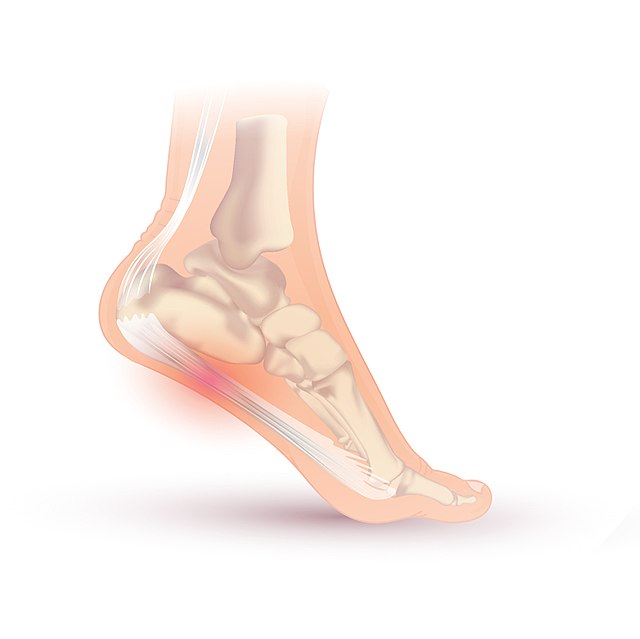What is plantar fasciitis?
 Plantar fasciitis (plan·tuh fa·shee·ai·tuhs) is the most common cause of heel pain estimated to affect 1 in 10 of us at some point in our lives, and of these, roughly 1/3 will have it in both feet.
Plantar fasciitis (plan·tuh fa·shee·ai·tuhs) is the most common cause of heel pain estimated to affect 1 in 10 of us at some point in our lives, and of these, roughly 1/3 will have it in both feet.
The plantar fascia is a thick band of fibrous tissue that runs along the bottom of your foot from the heel bone (calcaneum) to your toes. It works like a tight rubber band to support the arch of your foot and shock absorption when you land your foot with each step. Repeated stretching and tearing can cause irritation or inflammation of the fascia, although the cause of fasciitis is not known in most cases.
Risk factors for developing plantar fasciitis
Even though there is no obvious cause, some factors can increase your risk of developing plantar fasciitis (PF). They include:
Age - PF can happen at any age but the highest occurrence is seen in individuals aged between 40 and 60 years. This may have to do with the plantar fascia becoming less like a rubber band as we age.
Weight - Up to 70% of patients with plantar fasciitis are overweight. Having a high body weight puts extra stress on your plantar fascia so, keeping a healthy weight can help prevent or resolve the problem.
Type of exercise - Similar to being overweight, weight-bearing activities that place a lot of stress on your heel - such as running, weight lifting, dancing, or skipping - may bring on the condition.
Foot mechanics - The mobility of your foot and ankle can be affected by you having flat feet, high arched feet, or tight calf muscles (tightness of the Achilles is found in over 80% of cases of PF). These affect how weight is distributed across your feet when you're upright which can contribute to your developing fasciitis.
![Heel spur]() Heel spur
Heel spur
Do heel spurs cause plantar fasciitis?
A heel spur is an outgrowth of bone from the weight-bearing area of the heel bone. It is normally a chance finding when an x-ray of the foot is done for other reasons.
Having a heel spur does not mean you will get pain from it. Less than half of cases with plantar fasciitis have a heel spur.
Symptoms of plantar fasciitis
Heel pain or pain in the arch of the foot that is worse getting up first thing in the morning or after a period of prolonged sitting. The pain can be bad enough to make your first couple of steps be taken gingerly. After a few minutes of walking, the pain decreases as the fascia is stretched.
Gradually worsening heel pain with prolonged periods of standing or walking long distances.
Diagnosing plantar fasciitis
Diagnosis is fairly straightforward from the medical history you provide and a thorough physical examination carried out by your physician. Further confirmation can be achieved with ultrasound imaging performed at your outpatient appointment.
Occasionally further imaging tests like a magnetic resonance imaging (MRI) scan may be requested to rule out other conditions that can present like PF.
During your clinical evaluation risk factors for developing PF will also be explored and, if necessary, addressed.
What else can cause heel pain?
It's important to appreciate that there are different causes of heel pain, other than plantar fasciitis. Conditions like:
- Calcaneal (heel bone) stress fracture
- Plantar fascia rupture/tear
- Heel fat pad atrophy/wasting
- Tarsal tunnel syndrome - a nerve entrapment syndrome.
Though rarer, it is important that these conditions don't get missed as some cases may require urgent medical attention.
Ignoring plantar fasciitis can lead to chronic heel pain that hinders your regular activities. Changing the way you walk as a way to relieve your foot pain might lead to further problems of the foot, knee, hip or back.
How do you treat plantar fasciitis?
Although it can be debilitating, take comfort in the knowledge that roughly 90% of cases of plantar fasciitis improve within 6 months with non-operative treatments. Examples of at-home remedies you can do include:
- Regular gentle stretching exercises targetting the calf muscles. This can be instructed by a physical therapist.
- Standing on a frozen water bottle or applying an ice pack to the painful area for 10 to 15 minutes three to four times a day
- Use a cushioned heel gel inside your shoes
- Wear supportive shoes. Some people find it more comfortable wearing a heel lift in their footwear.
For those cases that don't respond to early conservative treatment, further options include:
- Extracorporeal shockwave therapy (ESWT)
- Platelet Rich Plasma injection
- Getting shoe inserts following assessment by a podiatrist
- Corticosteroid injection - usually reserved as a last resort when all other methods have failed.
If you have heel pain that is affecting your quality of life
make an appointment to see Dr. Ade.
 Plantar fasciitis (plan·tuh fa·shee·ai·tuhs) is the most common cause of heel pain estimated to affect 1 in 10 of us at some point in our lives, and of these, roughly 1/3 will have it in both feet.
Plantar fasciitis (plan·tuh fa·shee·ai·tuhs) is the most common cause of heel pain estimated to affect 1 in 10 of us at some point in our lives, and of these, roughly 1/3 will have it in both feet.